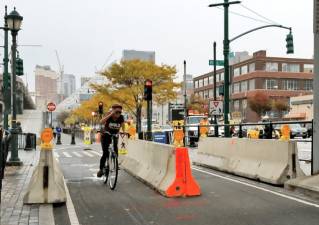“Don’t Be a Jerk” — The Wrong Message at the Wrong Time
This week, the New York City Department of Transportation began promoting its online (and thankfully multilingual) “Bike Smart Pledge,” asking cyclists to yield to pedestrians, stop at red lights and stop signs, ride in the direction of traffic, stay off the sidewalk, and have the proper lighting when riding at night. This will soon be followed by DOT’s “Don’t Be a Jerk” campaign, which will include a series of radio and TV PSAs as well as billboards encouraging cyclists to ride responsibly.
While it’s true that there are a lot of inexperienced riders giving cycling a try this time of year, and many seasoned New York City cyclists need to take DOT’s advice, the “Don’t Be a Jerk” PSAs use the language of the bike backlash itself, indelibly linking the words “jerk” and “cyclist” together in the minds of people already inclined to think that cyclists are jerks. Plastering the city with billboards with these words may have the unintended effect of reinforcing the commonly held idea that cyclists, unlike motorists, are only as deserving of dedicated infrastructure as their behavior proves them to be.
The fact is that reckless riding is hardly the threat to public safety it’s made out to be in countless newspaper editorials and TV news segments. Cyclists were responsible for zero pedestrian fatalities in 2010, but car crashes claimed the lives of 269 people. But the DOT has never done a safe driving campaign that asks motorists to stop driving like jerks.
Then again, changing the way cyclists ride may be the least of the campaign’s goals.
The Department of Transportation has not been able to turn the tide of negative PR emanating from a handful of vocal critics, despite polling that shows the popularity of bike lanes, pedestrian plazas and other new street designs. Given the hostile media and political environment in which the DOT finds itself defending its policies and projects, the department may think that taking a strong stance against reckless riding will help fend off attacks as it pursues future bike-related projects.
It won’t work. When even a respected New Yorker writer like John Cassidy claims that bike lanes are “a classic case of regulatory capture by a small faddist minority,” hoping to placate a conflict-driven media catering to an auto-dependent audience is an exercise in futility.
A more effective campaign would put facts and figures – something so sorely missing from the general discussion about bike lanes – front and center for all to see. DOT should be aggressively touting its accomplishments and emphasizing the ways in which bike lanes make all road users safer. Deputy Mayor Howard Wolfson has been taking this approach on behalf of the administration, but he can’t be a one-man messaging machine forever.
The city’s public messaging on cycling and sharing the road should also show that people who use bicycles for transportation are, in fact, real New Yorkers who simply want to get to work, school or the grocery store as safely as they can, and that everyone stands to benefit from a city where fewer people, no matter how they get around, act like jerks.

